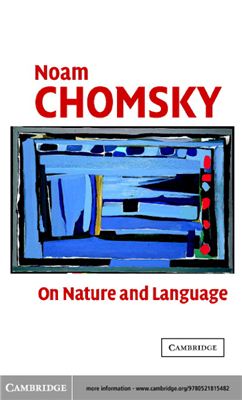The first chapter provides an introduction to some basic con-
cepts of linguistic theory and to some elements of the history of the
fieldwhich are crucial for understanding certain theoretical questions
addressed in the following chapters.
The second chapter is related to a particular occasion.
Chomsky’s sojou in Siena was organized twenty years after his visit
to the Scuola Normale Superiore of Pisa, an event which, through
the memorable Pisa Lectures, has profoundly influenced the field of
theoretical linguistics ever since. In connection with this anniversary,
Chomsky received, onOctober 27, 1999, the Perfezionamento honoris
causa, thehonorarydegreedeliveredby theScuolaNormaleSuperiore.
In that occasion, he gave the Galileo Lecture Perspectives on Lan-
guage and Mind, which traces central ideas of current scientific lin-
guistics and of themode cognitive sciences to their roots in classical
thought, starting with Galileo Galilei’s famous praise of the mar-
velous invention, alphabetic writing, which allows us to communi-
cate with other people, no matter how distant in space and time.
The Galileo Lecture is published here as the second chapter.
The third chapter is focused on the relations of the study of
languagewiththebrainsciences; it addresses inparticular theperspec-
tives for an integration and unification of the abstract computational
models,developedby the cognitive sciences,withthe studyof thephys-
ical substrate of language and cognition in the brain. A preliminary
version of this text was read by Chomsky as a plenary lecture at the
meeting of the European Conference on Cognitive Science (Santa
Maria della Scala, Siena, October 30, 1999); the same issues were
also addressed in a somewhat more general setting in the public
lecture Language and the Rest of the World (University of Siena,
November 16, 1999).
The fourth chapter presents, in the form of an interview, a dis-
cussion on the historical roots, concepts, and ramifications of the
Minimalist Program, the approach to language which took shape un-
der the impulse of Chomsky’s ideas in the course of the 1990s, and
which has progressively acquired a prominent place in theoretical
linguistics.
217 pages, Cambridge University Press
cepts of linguistic theory and to some elements of the history of the
fieldwhich are crucial for understanding certain theoretical questions
addressed in the following chapters.
The second chapter is related to a particular occasion.
Chomsky’s sojou in Siena was organized twenty years after his visit
to the Scuola Normale Superiore of Pisa, an event which, through
the memorable Pisa Lectures, has profoundly influenced the field of
theoretical linguistics ever since. In connection with this anniversary,
Chomsky received, onOctober 27, 1999, the Perfezionamento honoris
causa, thehonorarydegreedeliveredby theScuolaNormaleSuperiore.
In that occasion, he gave the Galileo Lecture Perspectives on Lan-
guage and Mind, which traces central ideas of current scientific lin-
guistics and of themode cognitive sciences to their roots in classical
thought, starting with Galileo Galilei’s famous praise of the mar-
velous invention, alphabetic writing, which allows us to communi-
cate with other people, no matter how distant in space and time.
The Galileo Lecture is published here as the second chapter.
The third chapter is focused on the relations of the study of
languagewiththebrainsciences; it addresses inparticular theperspec-
tives for an integration and unification of the abstract computational
models,developedby the cognitive sciences,withthe studyof thephys-
ical substrate of language and cognition in the brain. A preliminary
version of this text was read by Chomsky as a plenary lecture at the
meeting of the European Conference on Cognitive Science (Santa
Maria della Scala, Siena, October 30, 1999); the same issues were
also addressed in a somewhat more general setting in the public
lecture Language and the Rest of the World (University of Siena,
November 16, 1999).
The fourth chapter presents, in the form of an interview, a dis-
cussion on the historical roots, concepts, and ramifications of the
Minimalist Program, the approach to language which took shape un-
der the impulse of Chomsky’s ideas in the course of the 1990s, and
which has progressively acquired a prominent place in theoretical
linguistics.
217 pages, Cambridge University Press

